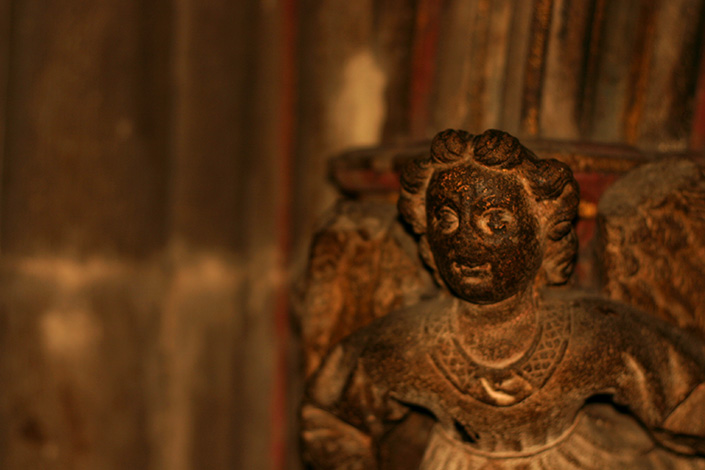Worn Angel
I had one chance to do this shot — I had to diffuse the flash and guess the exposure. Turned out about as creepy as it appeared in real life; it was a tour de force in whatever limited photo skills I possess.
Lens at 50mm, ISO 100, ƒ/2.5, 1/60s
Snapped Jun 5, 2008 at 3:44am

Comments
Sagert
Pardon me for letting my ignorance show, but for those of us not as talented, how did you diffuse your flash?
Alexander Micek
No - no ignorance! Here’s the problem, start to finish: the light was so low that even a very fast lens (f/1.8 in this case) couldn’t focus without flash assistance. What the flash does to assist is strobe repeatedly, giving the autofocus system enough contrast to pull the scene into focus. We’ve all seen cameras do this — unfortunately it’s a huge battery drain because you are taking the flash, a light that is supposed to be used in really fast bursts, and trying to have it essentially be lit steadily.
To add to this issue, there’s the focus itself, which is off-center. Unfortunately, on the camera I have, the focus points that aren’t in the center require more light to lock focus. We’ll return to that in a second.
I also knew from experience that the on-camera flash is harsh — it projects a small pinpoint of light from a location very close to the lens — a recipe for red eye and in this case glare. So, I needed something to make the light source “larger” — something to diffuse the light source.
(A quick side-note: there is a period called “magic hour” at the beginning and end of the day. It is called this because pictures during this time tend to turn out quite well. After a bit of digging, I finally found a good summary of why this is the case — instead of a small, really bright, pinpoint of light (the sun), the entire sky is acting as a giant diffuse light source (sun is near the horizon). As a result, everything you shoot appears as though you are in a light tent / soft box. So, diffusing the light = good stuff.)
So, how to diffuse? Well, for a second I thought I was hosed, because I usually use a piece of printer paper folded in half, held about an inch in front of the flash. Who has printer paper when they’re touring Europe? What I did have, however, was a tourist guidebook; I held a few pages of it in front of the flash to diffuse it.
But how to get the exposure right when the flash is shooting through paper? Well, I knew that this flash, when fired on manual mode, would correctly expose a subject about 6 feet away at 1/60s, ISO 100. Well, I was much closer than 6 feet, shooting through two pieces of paper… so I hit ISO 100 and 1/60s and picked an aperture that would yield a decent depth of field but was still pretty wide open.
But here’s why I only had one chance to do this — my battery is original to the camera, so it’s very hard to get the thing to hold a charge! It was the beginning of the day, so I had to use as little battery power as possible. Thus, I had one shot.
The process went like this: twiddle all the dials for the settings and then hold the camera in my right hand, with guidebook-diffuser at the ready. Remember how I said the off-center focus points need as much light as possible? Because of this, I had to not cover the flash with the diffuser while the camera focused — it needed all the light it could get. Then, the instant the camera locked focus, I put the diffuser in front of the flash, and took the picture.
Sagert
now there’s a man who knows his camera well.
Nils
Well done Alex. And I will second Sagert’s comment.